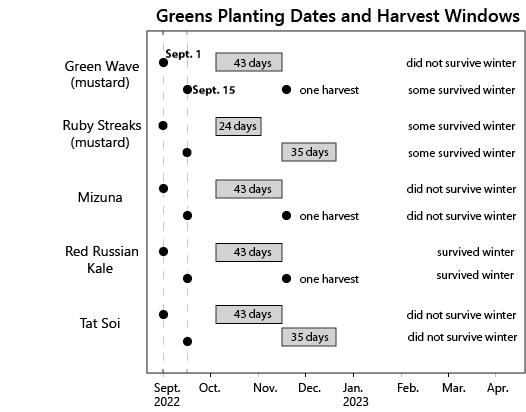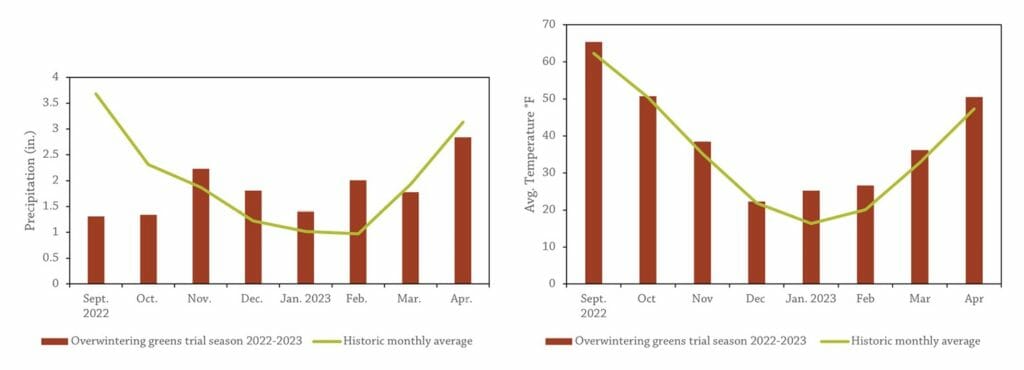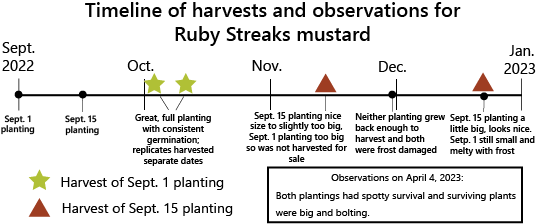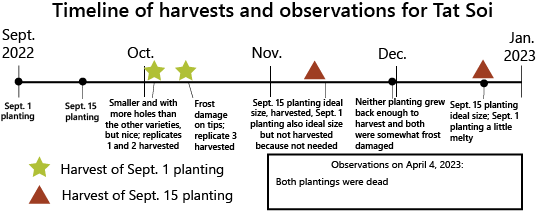This research was funded by Ceres Trust.
In a Nutshell:
- Farmers Hannah Breckbill and Emily Fagan already grow overwintered spinach and are interested in growing a wider variety of types of greens for their customers through the late fall and winter months.
- They conducted a qualitative trial where they planted five leafy greens varieties on two dates (Sept. 1 and Sept. 15, 2022) and made detailed observations about germination, crop condition, and harvestability.
Key Findings
- Earlier planting date (Sept. 1) resulted in better germination and better fall harvestability across all varieties.
- All varieties were harvestable in October and November. The Sept. 15 plantings of tat soi and Ruby Streaks mustard were harvestable in late December. No varieties were harvestable in the spring, though.
Background
Iowa vegetable producers frequently overwinter spinach in hoop houses and under mulch for a delicious winter and early-spring crop. Farmers Hannah Breckbill and Emily Fagan wondered whether other salad greens crops could be overwintered as well. Overwintering other varieties would increase the variety of produce they have available for their customers in the late fall and early spring and therefore improve farm financial viability and total crop production. Fagan says they took on a trial to explore this question because “we’re excited to learn more ways to extend our growing season and get a jump-start in the spring.” They seeded succession plantings of five leafy greens (Green Wave mustard, Ruby Streaks mustard, Red Russian kale, tat soi, and mizuna) on Sept. 1 and Sept. 15, 2022, and made detailed observations of plant growth and harvestability several times a month through April 2023.
Methods
Design
Breckbill and Fagan directly seeded five leafy salad greens varieties in three replications on two different seeding dates (Sept. 1 and 15, 2022) for a total of 15 replications (Figure A1). The seed bed was prepared by hoeing the bed to clear any weeds, making furrows for the seeds and covering everything with a layer of compost. Seeds were spaced about ½ inch apart and the rows were about 8 inches apart. Seeds were planted in an outdoor bed and then the high tunnel was moved over them in early November for cold protection. Plants were also covered with row cover for flea beetle protection and cold protection throughout the growing season.
Measurements
This was an observational study. Breckbill and Fagan documented observations about plant condition several times each month starting from germination in Fall 2022 until early April 2023 when all varieties were either dead or bolted. Observations were recorded on Oct. 4, Oct. 11, Oct. 14, Oct. 28, Nov. 16, Nov. 29, Dec. 21, and April 4. Observations on each date included germination quality, pest damage, size and number of leaves, frost damage or bolting affecting leaf quality and whether the crop was harvestable. Harvest window is defined as the amount of time between the date that two or more replicates were first able to be harvested to the date that no replicates were able to be harvested.
Results and Discussion
Establishment and Harvestability
The Sept. 1 planting of each of the five varieties germinated nicely and were ready to harvest after a month had passed by Oct. 4 (Figure 1). In contrast, the replicates planted on Sept. 15 of all varieties were slow to germinate and grow, with the first harvests of Green Wave, Ruby Streaks, Red Russian kale and tat soi not occurring until Nov. 16; roughly two months after planting. The Sept. 15 planting of mizuna never grew big enough to be harvested. Fagan reflects that the Sept. 15 plantings might have germinated sooner and been more harvestable if they had been watered earlier in the fall and if the treatments had been more spaced out; the Sept. 1 plantings were shading out the Sept. 15 plantings in some cases.

FIGURE 1. Harvest windows of the five greens varieties Breckbill and Fagan trialed over late fall 2022 and winter 2023.
The Sept. 1 plantings of all varieties except Ruby Streaks were harvestable through the beginning of November. The Sept. 15 plantings were harvested once or twice, through early or mid-December. By Nov. 29, all varieties in both plantings displayed frost damage, and by Dec. 21 all plantings were very frost damaged (“melty looking”) except for the Sept. 15 tat soi, Sept. 15 Ruby Streaks and both plantings of Red Russian kale (Figures 2-6).
None of the varieties were harvestable in early April 2023. However, Fagan says that they “did miss paying attention to them early in the spring and missed the window between spring regrowth and bolting for a few of the varieties.” Some plants in both Red Russian kale and Ruby Streaks plantings survived the winter and bolted by April. The Sept. 15 Green Wave planting had some spotty winter survival with small plants in April which may have germinated after lying dormant from the fall plantings. Fagan thinks they may be able to get an early spring crop from these varieties in future years though they will not count on it. Reflecting on this trial and previous experience overwintering greens, Fagan writes:
My general impression of overwintering plants is that every year has been very different from the one before. The conditions of the winter, for example the timing of cold snaps and warmups, seem to matter a lot and to impact things somehow more than weather changes impact summertime crops. So, it’s very hard to predict what might happen… My approach is to just keep trying and if something doesn’t make it through winter well one year, it might do a great job the next. You never know!
Conclusions and Next Steps
Breckbill and Fagan plan to grow all five of these varieties again as a fall crop and will use an early September seeding date. Fagan writes that “The goal of the trial was to pay attention to more qualitative details about overwintering these various greens, and this trial gave us a great chance to do that. It kept us accountable to weekly observations for a good while!” They learned that it makes a fairly big difference to plant the greens two weeks earlier and that spacing and watering promptly after planting is important to get the plants established as early as possible.
Appendix – Trial Design and Weather Conditions

FIGURE A2. Mean monthly temperature and rainfall during the study period and the long-term averages at the nearest weather station in Decorah. Click to enlarge.







